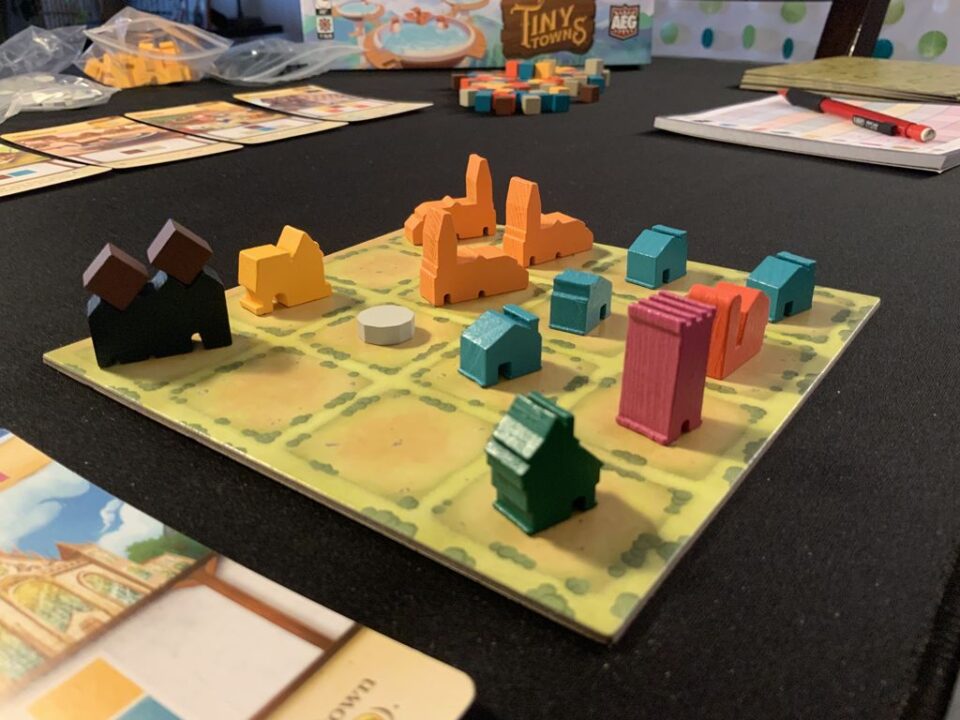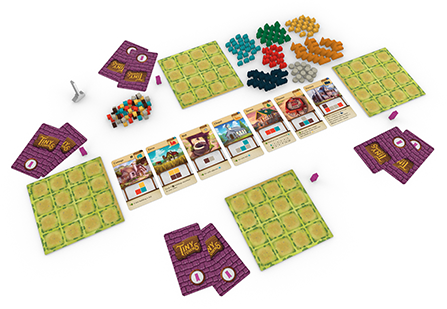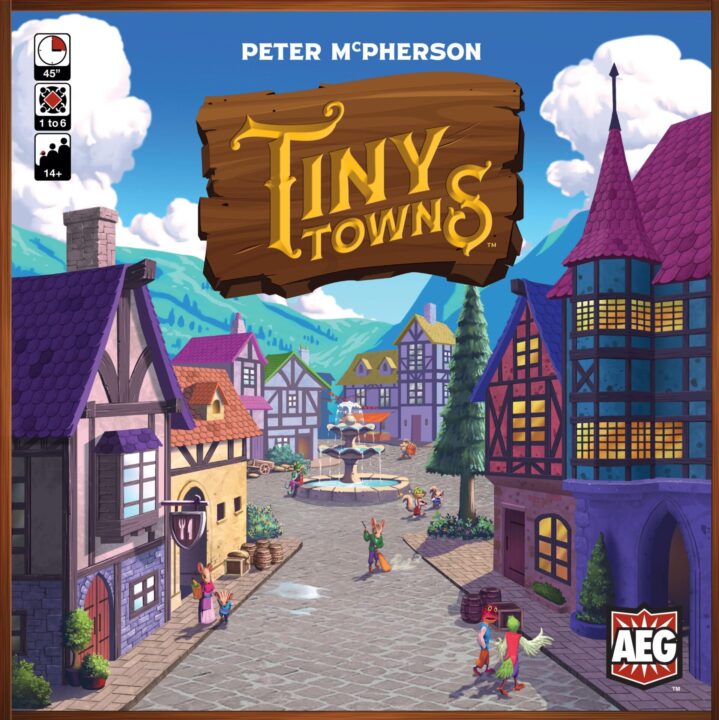Overview
Welcome to the quaint world of Tiny Towns, the subject of today’s spirited review! This inventive board game cleverly fuses resource management, strategic spatial planning, and player interaction into a compelling package that promises to entertain and challenge. As we construct our miniature metropolises, each decision feels weighted with consequence—yet the delightfully simple mechanics keep gameplay accessible for novices and master builders alike.
How It Plays
Setting Up
To begin Tiny Towns, each player receives a 4×4 grid representing their town. Resource cubes are placed within easy reach, and a set of Building cards is revealed for shared structures every player can construct. Each town starts with a randomly distributed set of resources to challenge and inspire players from the get-go.
Gameplay
During the game, players take turns as the Master Builder, selecting a resource for everyone to place on their grid. Strategic placement is key, as combining these correctly will allow players to replace resources with buildings. Each building scores points differently, and spatial consideration for future placements is paramount. Remember, space is at a premium!
Winning the Game
The game ends once no player can place more resources or construct buildings. Players tally their points, with negative points for unused squares. The player with the highest score’s town thrives best, earning them the victory in Tiny Towns.
Want to know more? Read our extensive strategy guide for Tiny Towns.
Mastering Tiny Resources
In Tiny Towns, the elegance of resource management always brings me back to the table. There’s something incredibly satisfying about efficiently using a limited set of tools to complete complex tasks. In this game, with every cube color representing a different resource, strategic allocation becomes a brain-buzzing dance.Adaptive Strategies
The unpredictability of the central deck teases out adaptive strategies, often leading to shifts in plans mid-game. I recall fondly when my table erupted in groans and laughter as we painstakingly navigated our personal resource droughts; the real triumph in Tiny Towns is intelligently pivoting when resources don’t fall your way.
Resource Roulette
Each round is a gamble, a fresh chance. Will this be the round I get wood for my granary? Anticipation builds; each player’s choice can ripple through others’ plans. During one zealous session, each pick became a communal moment of silent pleading, followed often by exasperated but cheery compromise.
The transition to discussing Puzzle-like Spatial Planning should be as smooth as fitting that last, game-winning building into your Tiny Town.

The Intricate Dance of Spatial Reasoning
Whenever I dive into my Tiny Towns Review, images of past game nights flicker in my mind, each turn a vivid dance of spatial planning. I remember one particular session where the room hummed with anticipation as we all silently puzzled over our town grids, trying to make everything fit just right.
Mastering the Tetris-like Challenge
It’s clear that Tiny Towns turns us into architects with a limited canvas. Calculating each placement so it contributes to a patterns’ culmination is nothing short of a delicate ballet—a series of pliés and jetés in planning form. There were tentative alliances over placements, celebrating every snug tile fit!
Maintaining Grid Harmony
The ascending tension when a flip of the game can lead to gridlock or the triumphant installation of a building drives the game’s heartbeat. Success requires a dexterity of decision, always preserving space for future moves.
Done well, players end the game like conductors of a block-filled symphony. Now, let’s traverse from silent strategy to social banter as I jog us into discussing Player Interaction Dynamics.

The Social Fabric of Tiny Towns
In my last review session, I smiled as chants of ‘Just not a brick, please!’ echoed around the table while playing Tiny Towns. The crux of our fun hinged upon the player interaction dynamics.
Making or Breaking Alliances
Each turn became a subtle negotiation. ‘If I choose wood, will you opt for glass next?’ we pondered openly, lending a sense of camaraderie to the strategy. That’s Tiny Towns’ beauty: it calls for foresight not just in the placement of resources, but also in the consideration of your neighbor’s ulterior motives.
Anticipating the Next Move
Then came the game-changing moves—’accidental’ choices that forced rivals to abandon well-laid plans. The gasps and the appreciative nods after such turns underscored a fascinating dynamic: player interactions in Tiny Towns aren’t just incidental; they’re pivotal. Do you enjoy the mental tango of anticipating others’ moves? If yes, Tiny Towns sings in harmony with your playstyle.
In the final assessment, my recommendation considers Tiny Town’s title as a heavyweight contender in your gaming library an affirmation of its engaging player dynamics.

Conclusion
Concluding our Tiny Towns review, it’s clear that this board game brilliantly marries resource management, strategic spatial planning, and dynamic player interaction into a compact yet rich experience. From the first few resource placements to the final thrilling reveal of the town you’ve built, Tiny Towns consistently challenges players and brings them together around a shared touchscreen, crafting endless stories with each playthrough. Whether it’s during a family game night or as part of a heavy-duty board game marathon, Tiny Towns lays out colorful, engaging fun, tucked neatly into the brain-burning puzzle. It’s a testament to game design where depth and accessibility coexist harmoniously. Overall, if you’re seeking a game to stimulate your mind and social circle, Tiny Towns earns its place in any collection.


